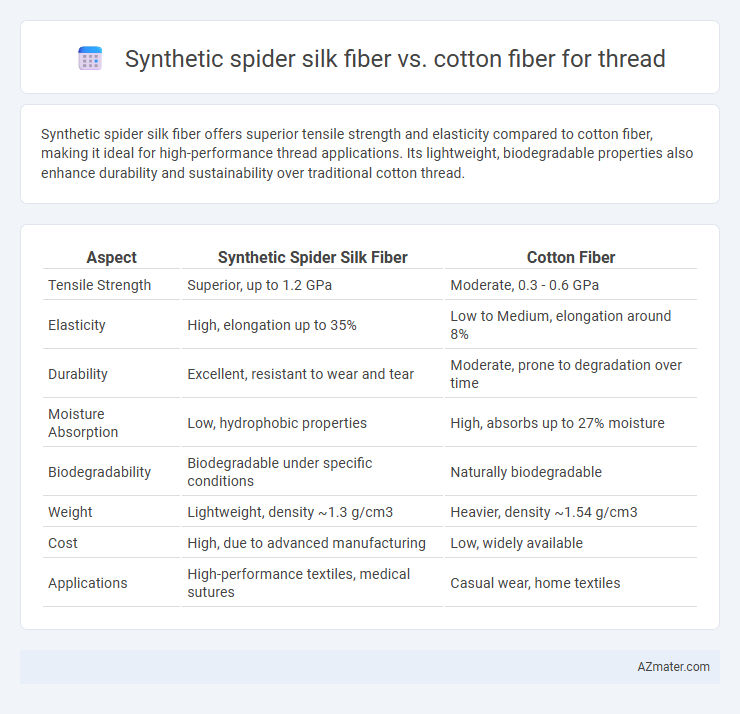Synthetic spider silk fiber offers superior tensile strength and elasticity compared to cotton fiber, making it ideal for high-performance thread applications. Its lightweight, biodegradable properties also enhance durability and sustainability over traditional cotton thread.
Table of Comparison
| Aspect | Synthetic Spider Silk Fiber | Cotton Fiber |
|---|---|---|
| Tensile Strength | Superior, up to 1.2 GPa | Moderate, 0.3 - 0.6 GPa |
| Elasticity | High, elongation up to 35% | Low to Medium, elongation around 8% |
| Durability | Excellent, resistant to wear and tear | Moderate, prone to degradation over time |
| Moisture Absorption | Low, hydrophobic properties | High, absorbs up to 27% moisture |
| Biodegradability | Biodegradable under specific conditions | Naturally biodegradable |
| Weight | Lightweight, density ~1.3 g/cm3 | Heavier, density ~1.54 g/cm3 |
| Cost | High, due to advanced manufacturing | Low, widely available |
| Applications | High-performance textiles, medical sutures | Casual wear, home textiles |
Introduction to Synthetic Spider Silk and Cotton Fibers
Synthetic spider silk fiber, engineered to mimic the exceptional tensile strength and elasticity of natural spider silk, offers superior durability and lightweight characteristics compared to traditional fibers. Cotton fiber, derived from the cellulose-rich seed hairs of the cotton plant, is renowned for its breathability, softness, and widespread use in textile manufacturing. High-performance applications increasingly favor synthetic spider silk for its biodegradability and enhanced mechanical properties, while cotton remains a dominant natural fiber valued for comfort and moisture absorption.
Composition and Structure of Spider Silk vs Cotton
Synthetic spider silk fiber replicates the protein-based composition of natural spider silk, primarily composed of fibroin proteins arranged in highly organized beta-sheet nanocrystals that provide exceptional tensile strength and elasticity. Cotton fiber consists mainly of cellulose, a polysaccharide composed of long chains of glucose units forming microfibrils with a crystalline and amorphous structure, which imparts softness and moderate strength but lacks the highly ordered protein matrix seen in spider silk. The hierarchical structure of spider silk with its combination of crystalline and amorphous protein regions offers superior durability and flexibility compared to the predominantly cellulose-based, less elastic cotton fibers used in thread production.
Strength and Durability Comparison
Synthetic spider silk fiber exhibits tensile strength up to five times greater than cotton fiber, making it exceptionally robust for thread applications. Its superior elasticity allows it to endure repeated stretching and stress without breaking, outperforming the relatively brittle nature of cotton fibers. The enhanced durability of synthetic spider silk results in longer-lasting threads that resist wear, moisture, and environmental degradation better than traditional cotton threads.
Flexibility and Elasticity Differences
Synthetic spider silk fiber exhibits superior flexibility compared to cotton fiber, allowing it to bend and twist without breaking. Its high elasticity enables it to stretch up to 30% of its original length and recover quickly, whereas cotton fiber has limited stretch and tends to lose shape over time. These properties make synthetic spider silk fiber ideal for applications requiring durable, stretchable thread with consistent performance.
Moisture Management and Breathability
Synthetic spider silk fiber offers superior moisture management compared to cotton fiber, wicking sweat away from the skin efficiently to keep the wearer dry. Its advanced nanostructure promotes enhanced breathability, allowing better airflow and temperature regulation during physical activity. Cotton fiber tends to retain moisture longer, which can lead to discomfort and slower drying times under similar conditions.
Biodegradability and Environmental Impact
Synthetic spider silk fiber exhibits superior biodegradability compared to conventional cotton fiber, breaking down more efficiently without releasing harmful microplastics. Its production demands significantly less water and land, reducing carbon emissions and environmental strain compared to cotton farming, which involves intensive pesticide use and resource consumption. The eco-friendly profile of synthetic spider silk positions it as a sustainable alternative for textile threads, minimizing ecological footprints throughout its lifecycle.
Production Methods and Scalability
Synthetic spider silk fiber is produced through bioengineering techniques involving recombinant DNA technology in host organisms such as bacteria, yeast, or plants, enabling controlled protein expression for fiber spinning. Cotton fiber is harvested from cotton plants cultivated on a large scale using agricultural methods, relying on environmental conditions and traditional farming practices. Scalability of synthetic spider silk depends on advancements in bioreactor design and fermentation efficiency, while cotton benefits from established global farming infrastructure but faces challenges with water usage and land requirements.
Cost Efficiency in Thread Manufacturing
Synthetic spider silk fiber offers superior tensile strength and elasticity compared to cotton fiber, which can reduce material consumption in thread manufacturing. Despite higher initial production costs, synthetic spider silk's durability leads to lower replacement rates and improved lifecycle cost efficiency. Cotton fiber remains cheaper upfront but often incurs higher costs related to durability and labor-intensive processing.
Applications in Textile and Industrial Sectors
Synthetic spider silk fiber offers superior tensile strength and elasticity compared to cotton fiber, making it ideal for advanced textile applications requiring durability and flexibility. Its lightweight and biodegradability enhance performance in industrial sectors such as medical sutures, protective clothing, and high-performance composites. Cotton fiber remains prevalent for comfort-focused textiles but lacks the mechanical properties necessary for specialized industrial uses where synthetic spider silk excels.
Future Prospects and Innovations
Synthetic spider silk fiber exhibits superior tensile strength, elasticity, and biodegradability compared to traditional cotton fiber, positioning it as a transformative material for advanced textile applications. Innovations in bioengineering and scalable fermentation processes are accelerating the production of synthetic spider silk, promising sustainable and high-performance thread alternatives. Future prospects include the integration of synthetic spider silk in smart textiles, medical sutures, and eco-friendly fashion, driven by its durability and minimal environmental impact.

Infographic: Synthetic spider silk fiber vs Cotton fiber for Thread
 azmater.com
azmater.com